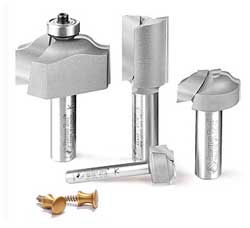
It is often said that you get what you pay for. Then why are the Woodline router bits so inexpensive? If it’s as good as they claim it to be, why would I continue to pursue the Freud’s and the Jesada’s? Is it the type of material, the production procedure, or craftsmanship? I have yet to see an article on head to head duel of the many bits out there. Why not?
Ellis Walentine: Most magazines wouldn’t touch a head-to-head comparison of router bits, because there are so many variables. Which bit(s) do you test? What do you test for? How do you test? Fine Woodworking ran a router bit test a few years ago and I don’t think anyone came away happy — least of all some of the manufacturers, who faulted the test parameters. I’m not sure the readers were well served either, because the test covered only one type of bit, a carbide straight bit, pushed to extremes. I viewed this as unfair because the subtle differences in balance and manufacturing really show up in larger and more complicated profiles. In a sense, this test presumed to tar the manufacturers’ entire product lines with the same brush, based on very limited testing.
There are definite differences between router bits, for example, the grade and composition of the carbide, the steel used for the blank, the accuracy of the machining and brazing, the balance and concentricity of the bit, the quality of the bearings, and, perhaps most important, the sophistication of the grinding on the tips.
Grinding is done by multiple-axis grinding machines, using diamond wheels and a constant flush of lubrication. Depending on the grit of the wheel and the type of lubricant, the ground surfaces may range from rough looking to highly polished. The finer the grit of the grinding wheel and the higher the polish, the sharper the bit–generally speaking. But, there are plenty of differing opinions on this as well.
There are some subtle differences in the grinding, too, including some very complicated “relief” angles. The untrained eye wouldn’t be able to see the difference in the bit itself, but it has a big impact on performance. Bits without the optimal relief angles tend to burn rather than cut cleanly, especially on certain smooth dense woods like maple and cherry.
There’s also the difference between machined blanks and cast steel blanks. Cast steel bits won’t hold up to extreme shocks the way bits machined from tool steel rods will. Again, how relevant is this really?
Even if you could sort out the minute differences between leading brands (and some generic brands), it would be largely an academic exercise. They all cut pretty darn accurately and some last a little longer than others. The price, as with most things, is as much a function of a company’s reputation and marketing effectiveness as the quality of their products. You get what you pay for, but it includes all these things.
Michael Dresdner: Wow, what a philosophical morass this question promises to open. Of course, we all know that price and quality are not always tied, though they often are. We also all know that one person’s bargain is another’s waste of money. But since you mention bits in particular, let’s talk about that.
In addition to accuracy (cheap bits are sometimes not exactly the diameter they profess to be) and the quality of metal and manufacture, there are issues like the thickness of the carbide. More expensive cutters may have thicker slabs of carbide … which means they can be sharpened more often. Of course, that may not be an advantage in some cases, so paying for that “quality” is false economy.
As for bit comparison, it has indeed been done, and will be again, no doubt, by various woodworking magazines, but like all comparisons, someone has to set “values,” and there is no guarantee that what some editor chooses as the important considerations will be the same as yours.
Bottom line: If cheaper bits work for you and do what you need them to do, buy them and be happy.
Rob Johnstone: I can’t speak specifically to the Woodline router bits. I have not used them and so I can’t say one way or the other about their quality. I do believe that the old saying is true — you need to pay for quality. The subtext of this discussion is: what degree of quality (how “good” of a router bit) do I require? To use an off-topic comparison, my rusty old ’91 Chevy pickup is sufficient to get me to work and back … and haul the variety of stuff (plywood, hunting dogs, rock-n-roll band equipment) that needs to be transported. I would much prefer to be commuting and hauling stuff around in a 2003 Dodge extended cab (bright red please) 4X4 pickup. (I can just see myself!) Will a less expensive router bit do the job for your woodworking tasks? I suspect yes, but only you would know. Will a less expensive bit last longer, cut a bit smoother and provide equal or better value in the long run? That is a trickier question. There was an attempt by another woodworking magazine to do a head to head comparison of carbide straight router bits. It caused an uproar and a lot of arguments on various web sites, but in my opinion, did not answer your question. In cases like this I hearken back to my dad’s advice … buy the best you can afford and you only cry once. But, then again, I am driving a ’91 rust-bucket!





